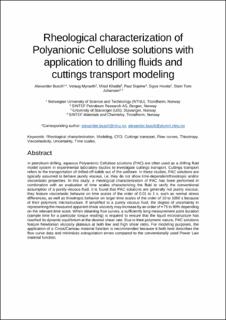| dc.contributor.author | Busch, Alexander | |
| dc.contributor.author | Myrseth, Velaug | |
| dc.contributor.author | Khatibi, Milad | |
| dc.contributor.author | Skjetne, Paal | |
| dc.contributor.author | Hovda, Sigve | |
| dc.contributor.author | Johansen, Stein Tore | |
| dc.date.accessioned | 2023-01-05T10:46:33Z | |
| dc.date.available | 2023-01-05T10:46:33Z | |
| dc.date.created | 2018-04-25T14:53:28Z | |
| dc.date.issued | 2018 | |
| dc.identifier.citation | Busch, A., Myrseth, V., Khatibi, M., Skjetne, P., Hovda, S., & Johansen, S. T. (2018). Rheological characterization of polyanionic cellulose solutions with application to drilling fluids and cuttings transport modeling. Applied Rheology, 28(2). | en_US |
| dc.identifier.issn | 1430-6395 | |
| dc.identifier.uri | https://hdl.handle.net/11250/3041165 | |
| dc.description.abstract | In petroleum drilling, aqueous Polyanionic Cellulose solutions (PAC) are often used as a drilling fluid model system in experimental laboratory studies to investigate cuttings transport. Cuttings transport refers to the transportation of drilled-off solids out of the wellbore. In these studies, PAC solutions are typically assumed to behave purely viscous, i.e. they do not show time-dependent/thixotropic and/or viscoelastic properties. In this study, a rheological characterization of PAC has been performed in combination with an evaluation of time scales characterizing the fluid to verify the conventional assumption of a purely-viscous fluid. It is found that PAC solutions are generally not purely viscous; they feature viscoelastic behavior on time scales of the order of 0.01 to 1 s, such as normal stress differences, as well as thixotropic behavior on larger time scales of the order of 10 to 1000 s because of their polymeric microstructure. If simplified to a purely viscous fluid, the degree of uncertainty in representing the measured apparent shear viscosity may increase by an order of ≈ 75 to 90% depending on the relevant time scale. When obtaining flow curves, a sufficiently long measurement point duration (sample time for a particular torque reading) is required to ensure that the liquid microstructure has reached its dynamic equilibrium at the desired shear rate. Due to their polymeric nature, PAC solutions feature Newtonian viscosity plateaus at both low and high shear rates. For modeling purposes, the application of a Cross/Carreau material function is recommended because it both best describes the flow curve data and minimizes extrapolation errors compared to the conventionally used Power Law material function. | en_US |
| dc.language.iso | eng | en_US |
| dc.publisher | de Gruyter | en_US |
| dc.relation.uri | http://www.ar.ethz.ch/cgi-bin/AR/view?DOI=10.3933/ApplRheol-28-25154 | |
| dc.subject | simulering | en_US |
| dc.subject | simulation | en_US |
| dc.subject | reologi | en_US |
| dc.subject | rheology | en_US |
| dc.subject | borevæske | en_US |
| dc.subject | drilling fluids | en_US |
| dc.subject | dypboringsteknikk | en_US |
| dc.subject | drilling engineering | en_US |
| dc.title | Rheological characterization of Polyanionic Cellulose solutions with application to drilling fluids and cuttings transport modeling | en_US |
| dc.type | Peer reviewed | en_US |
| dc.type | Journal article | en_US |
| dc.description.version | acceptedVersion | en_US |
| dc.rights.holder | The authors | en_US |
| dc.subject.nsi | VDP::Petroleumsteknologi: 512 | en_US |
| dc.subject.nsi | VDP::Petroleum engineering: 512 | en_US |
| dc.source.pagenumber | 1-16 | en_US |
| dc.source.volume | 28 | en_US |
| dc.source.journal | Applied Rheology | en_US |
| dc.identifier.doi | 10.3933/ApplRheol-28-25154 | |
| dc.identifier.cristin | 1581624 | |
| dc.relation.project | Norges forskningsråd: 228391 | en_US |
| cristin.unitcode | 217,8,6,0 | |
| cristin.unitname | Institutt for petroleumsteknologi | |
| cristin.ispublished | true | |
| cristin.fulltext | original | |
| cristin.qualitycode | 1 | |
